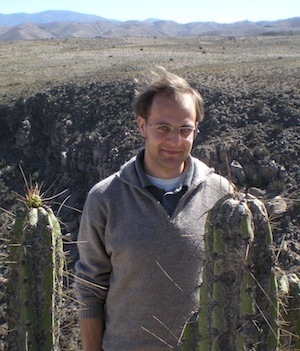About Me
I am a Lecturer in the Department of Mathematics at CU Boulder.
- Office
- MATH 237
- nicholas.matteo@colorado.edu
Research
My research is in discrete geometry, using tools from combinatorics, group theory, and topology. My dissertation research is about convex polytopes and tilings by convex polytopes having few flag orbits. My other interests include graph theory and combinatorial number theory.
My Curriculum Vitae.
Papers
N. Matteo. “Combinatorially two-orbit convex polytopes.” Discrete & Computational Geometry 55 (3), April 2016, pp. 662–680. arXiv:1411.1782 [math.MG].
N. Matteo. “Two-orbit convex polytopes and tilings.” Discrete & Computational Geometry 55 (2), March 2016, pp. 296–313. arXiv:1403.2125 [math.MG].
P. Larson, N. Matteo, S. Shelah. “Majority decisions when abstention is possible.” Discrete Mathematics 312 (7), April 2012, pp. 1336–1352. arXiv:1003.2756 [math.CO].
N. Matteo, Y. Morton. “Ionosphere Geomagnetic Field: Comparison of IGRF Model Prediction and Satellite Measurements 1991–2010.” Radio Science 46 (4), August 2011, RS4003. DOI: 0.1029/2010RS004529.
N. Matteo, Y. Morton. “Higher-order ionospheric error at Arecibo, Millstone, and Jicamarca.” Radio Science 45 (6), December 2010, RS6006. DOI: 10.1029/2010RS004394.
N. Matteo, Y. Morton, P. Chandrasekaran, F. van Graas. “Geographical dependency of higher order ionosphere errors.” Proceedings of ION GNSS 2009, Savannah, GA, September 2009, pp. 2739–2750.
Teaching
2017–2022: Teaching at CU Boulder: Statistics, Data & Models, Math Analysis for Business, Precalculus, Quantitative Reasoning. Course materials are all on Canvas.
2015–2016: MATH 1505: Mathematics for the Life and Social Sciences. Course materials are on Moodle.
Fall 2014: MATH 1215: Mathematical Thinking. Syllabus.
Spring 2014: MATH 1251: Calculus and Differential Equations for Biology. Syllabus.
Fall 2013: MATH 1215: Mathematical Thinking. Syllabus.
Spring 2013: MATH 1215: Mathematical Thinking. Syllabus.
Fall 2012: MATH 1231: Calculus for Business and Economics. Syllabus.
Fall 2011: MATH 1231: Calculus for Business and Economics. Syllabus.
Spring 2011: MATH 1251: Calculus and Differential Equations for Biology. Syllabus.
Fall 2010: MATH 1251: Calculus and Differential Equations for Biology.
Other things
See the video of my talk at the Fields Institute for the Retrospective Workshop on Discrete Geometry, Optimization, and Symmetry (November 2013).
A well-regarded answer on Math.StackExchange: What is the Coxeter diagram for?
A little-regarded answer on Math.StackExchange, of which I'm fond:
Finite Vertex-Transitive Planar game of Civilization.
Civilization is a game played on a tiled surface representing the Earth.
Typically the tiled surface is a cylinder (the arctic and antarctic regions are impassable)
or sometimes a torus (when the north end of the map wraps to the south, as well as east to west.)
As far as I know, it hasn't been tried on the real projective plane or the Klein bottle.
The questioner wanted to do a tiling on the sphere, like Earth's surface,
while keeping vertex-transitivity for “strategic fairness.”
I explained that this is impossible, for the large vertex numbers required.
Somehow, vertex-transitivity doesn't like even-dimensional spheres (unit spheres in odd-dimensional space).
I think this is related to the Hairy ball theorem,
and to the fact that the only group which acts freely on points on an even-dimensional sphere is Z/2Z.
Factor for TI-Basic.
Polytope links
- Atlas of Small Regular Polytopes
- Atlas of Polytopes for Small Almost Simple Groups
- Marston Conder's home page has lists of various classes of maps, and all regular and chiral polytopes up to 2000 flags
- Uniform Polytopes in Four Dimensions
- The Geometry Junkyard
- Virtual Polyhedra
- The Mathematial Atlas: 52B: Polytopes and Polyhedra
- Netlib polyhedron database
- How to sew a hyperbolic blanket
- Polytopes & their incidence matrices
- Counting polyhedra
- Symmetry & Polyhedra, including Enumeration of polyhedra
- Interesting questions on MathOverflow:
- Can you determine whether a graph is the 1-skeleton of a polytope?
- Higher dimensional generalization of: Any quadrilateral tiles the plane? (Any polyhedron which tiles must have 0 Dehn invariant)
- Extensions of Eberhard's theorem
Graph data
- Combinatorial data (McKay): Complete collections of various classes of graph, up to some number of vertices, in graph6 format.
- Gordon Royle's Data: Class 2 graphs up to 9 vertices, trees up to 16, bipartite up to 14, 3-regular up to 22, and more.
- Regular Graphs (Meringer)
- Grout's Graphs
- Strongly regular graphs on at most 64 vertices (Spence)
- Graph descriptions (Brouwer)
- Sage graphs have a built-in database (up to 7 vertices), potentially extensible up to 8 vertices.
- Some caveats using Mathematica's GraphData
- The House of Graphs
